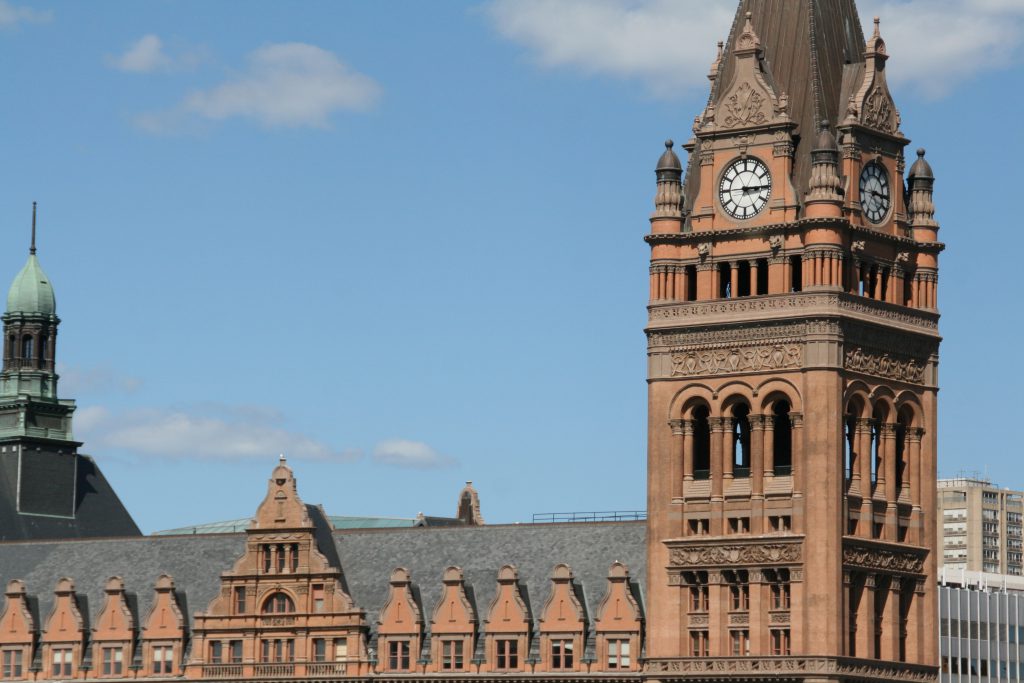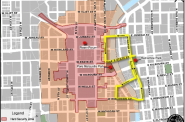$1.6 Billion Adopted Budget Raises Fees, Cuts Police
City's fiscal challenges continue to mount under state restrictions, rising costs.
The Common Council approved a $1.6 billion budget for 2021 Friday afternoon that reduces the size of the Milwaukee Police Department by at least 120 officers, creates a new street lighting fee and reduces the property tax rate as the city grapples with pandemic-induced challenges, structural budget issues and a looming need to provide $100 million annually to fund the city’s pension system.
The council approved the budget on an 8-7 vote, the narrowest margin in many years. The close vote reflects the increasing fiscal challenges the city faces, many of which have been growing for years.
Mayor Tom Barrett proposed his executive budget in late September, with the council spending the next month listening to hours-long department presentations and then introducing amendments. Almost half of the approved amendments are policy footnotes — effectively requests to city departments to implement a new program or expand an existing one.
One of the biggest challenges the city faces is the growing cost of public safety employees. The MPD budget has exceeded the city’s property tax levy for five years in a row, a level Barrett and other council members refer to as “unsustainable.”
Barrett proposed a 120-officer reduction, achieved by attrition, not layoffs, but at a savings of only $432,000. The police department’s sworn strength would fall to 1,682 by the end of 2021.
“Many people are probably wondering, how can it be that the police budget is almost the same as it was last year, and at the same time 120 police positions will not be filled next year? The answer is we cut salaries by $8.5 million, but police health care and other personnel costs have risen and chewed up those budgetary savings,” said Barrett in delivering his budget address.
The sworn strength reduction could expand to 150 with no additional immediate savings. Separate from the budget, a federal COPS grant could be rejected by the council.
The grant would fund a 30-member recruiting class in 2021. The grant acceptance file was referred back to committee on Wednesday so the council could learn more about the long-term impacts of accepting the grant.
Amendments
An omnibus amendment includes the biggest changes to Barrett’s budget.
Council President Cavalier Johnson and Finance & Personnel Committee chair Michael Murphy led the creation of the amendment. The amendment provides $500,000 for Alderwoman Marina Dimitrijevic‘s SafeHomes lead abatement initiative aimed at subsidizing private, voluntary abatement projects, $50,000 in funding for the Community Collaborative Commission to pursue justice initiatives, sets aside $200,000 for a second round of Fresh Food Access Fund grants, adds unfunded lead abatement positions to the Milwaukee Health Department and Department of Neighborhood Services to be supported by carryover funds, adds $60,000 in funding for the Milwaukee Arts Board and allocates $300,000 to Milwaukee County to support the mental-health-focused Crisis Assessment and Response Team (CART) program.
The amendment is funded by cutting $300,000 from MPD’s crossing guards program, expected to be unused because of a reduction in in-person schooling, and cutting all funding set aside for the Strong Home Loans Program ($100,000) and the Mayor’s 10,000 Homes Initiative ($400,000). Additional proceeds would come from lifting a licensing fee moratorium instituted during the pandemic.
“I tend to believe if we were all in the same room humanly over the past few months we could have got more done,” said Dimitrijevic to her colleagues, 12 of which were participating remotely. She had a lengthy back-and-forth about lead abatement strategies with Lewis early in the five-hour meeting that seemed closer to a conversation colleagues might have in the hallway than dueling floor speeches in the council chamber.
Dimitrijevic also successfully secured approval of an amendment that extends the SafeVote postcard program through spring 2021. The program, introduced for the August primary, mails all Milwaukee households instructions on how to request an absentee ballot. Her amendment, which has a cost of $162,576 paid for by cutting police overtime, will also pay for voter assistance workers at city libraries in advance of the April 2021 election.
“This taxpayer sponsored voter card is a waste of money,” said Borkowski. “I don’t think it matters how many pieces of lit you get, you’re not going to go out for school board like president.” Dimitrijevic said the program was a key driver of the city’s record absentee turnout in November. The cut to police overtime requires the department to hit the target dollar amount; budget director Dennis Yaccarino said they had overshot the figure in recent years.
A pilot program for unarmed first responders run through the Milwaukee Fire Department was withdrawn by sponsors Lewis and Dodd after it was determined the revenue source they wanted to use, unspent funds from 2020, would not be recognized as available until spring 2021.
A study of a permanent program is underway and acting chief Aaron Lipski questioned the wisdom of a pilot program when it was introduced last week. “We bristle a little at creating an unarmed first responder program because you already have one, it’s called the fire department,” said Lipski. “We already respond to many of these emergencies.”
The discussion of the program involved a number of inaccurate assertions by Dodd, including that there was a single 911 system (it’s split between fire and police currently) and that CART amendment funding would go directly to pay for police officers (the funds cover clinicians, MPD would have to fund three assigned officers internally). But it was revealed that the amendment itself was pointed at the wrong funding source, a $500,000 blanket cut to MPD that could have triggered layoffs. Lewis, who subtly issued a number of corrections, ultimately moved to withdraw the proposal and said she would bring up a revised version when the carryover funds were recognized in 2021.
Murphy successfully introduced a proposal to fund a fourth study of resident perceptions of safety and MPD by cutting an open position from the Fire & Police Commission. The last study was released in October. “The responses are very telling and helpful,” he said. “I do believe with everything that has happened in 2020, next year will be very important to find out where we are.”
The budget includes the closure of a fire department engine company on the city’s Far South Side. Area Alderman Scott Spiker unsuccessfully introduced amendments to fight the closure and opposed many of the fee increases. “I cannot with good conscience go to my constituents, say you’re losing an engine company, you’re losing service, but here you go with a street lighting fee,” he said.
The city faces a number of challenges beyond the pandemic, including annually rising costs and state-imposed restrictions on taxation coupled with stagnant levels of revenue from the state.
“This is a very, very difficult budget for 2021, with many financial challenges amid the pandemic,” said Murphy. “We did try to listen as much as we can with the limitations that have been placed on the City of Milwaukee, in many respects by the state legislature.”
The city entered the year with a $60 million structural gap, a measure of the growth in revenues versus the growth in costs to maintain the status quo, according to the budget office.
State law, instituted under then-Governor Scott Walker, prevents municipalities from raising its property tax levy by more than the value of new construction. Other state regulations prevent the city from instituting sales or payroll taxes that could allow the city to capture revenue from employers or events.
Compounding the revenue limitations are declining revenue sources. Adjusted for inflation, the city receives over $100 million less annually than it did in 2003 under the state’s shared revenue program, created decades ago as a return of income tax dollars. The amount previously exceeded the annual costs of the police department.
More problems are on the horizon.
Starting in 2023, a five-year smoothing formula is expected to increase the city’s annual pension fund contribution by $100 million. The cost increase is driven by a reduction in expected returns and an increase in the pension costs for public safety employees.
What Will A Homeowner Pay in 2021?
A homeowner with a property assessed for $126,235, the city average, will see their city property tax bill (excluding other property taxing entities) and fees increase by $86.11 in 2021.
That total is down by $3.47 compared to Barrett’s proposal as Stamper successfully introduced an amendment that reduces crossing guard funding from the police department, projected to go unspent because of the pandemic, and used the savings to reduce the street lighting fee.
Over half of the 2021 increase will go towards fee increases, which are levied against tax-exempt properties like churches.
A $10 vehicle registration fee (wheel tax) increase is also included. The fee would bring in an extra $3 million on top of the existing $20 fee. The proceeds have reduced the street replacement cycle by several decades.
The actual property tax rate is declining, from $10.58 per $1,000 of assessed value to $10.06. The council amendments cut the property tax levy amount, but not by enough to change the rate. The rate can go down because the value of property in the city is increasing. Milwaukee Public Schools, Milwaukee Area Technical College, the Milwaukee Metropolitan Sewerage District and Milwaukee County also levy property taxes.
The city’s levy in 2021 is slated to be approximately $299 million, an increase of $8 million.
The budget could still change around the edges. Barrett maintains a line-item veto and has used his power in recent years to send specific items back to the council with recommendations for changes.
UPDATE: An earlier version of this article said a waiver was pending for the COPS grant. It has been granted.
If you think stories like this are important, become a member of Urban Milwaukee and help support real, independent journalism. Plus you get some cool added benefits.
More about the 2021 Milwaukee Budget
- City Hall: Council Delays on Federal COPS Grant - Jeramey Jannene - Nov 25th, 2020
- City Hall: Council Overrides One of Two Barrett Vetos - Jeramey Jannene - Nov 24th, 2020
- City Hall: Barrett Issues Two Budget Vetoes - Jeramey Jannene - Nov 18th, 2020
- City Hall: $1.6 Billion Adopted Budget Raises Fees, Cuts Police - Jeramey Jannene - Nov 6th, 2020
- Transportation: Budget Amendment Would Move Milwaukee Towards “Vision Zero” - Jeramey Jannene - Oct 30th, 2020
- City Hall: Committee Approves Over 20 Amendments To Milwaukee Budget - Jeramey Jannene - Oct 30th, 2020
- City Hall: Almost Half of Budget Amendments Are Policy Footnotes - Jeramey Jannene - Oct 29th, 2020
- City Hall: Community Groups Propose Changes - Jeramey Jannene - Oct 19th, 2020
- City Hall: City Could Lose 30 More Police Officers - Jeramey Jannene - Oct 19th, 2020
- Transportation: Should Milwaukee Stop The Hop? - Jeramey Jannene - Oct 13th, 2020
Read more about 2021 Milwaukee Budget here
Political Contributions Tracker
Displaying political contributions between people mentioned in this story. Learn more.
- December 31, 2019 - Marina Dimitrijevic received $50 from Nikiya Dodd
- March 26, 2016 - Chantia Lewis received $50 from Nikiya Dodd
- March 26, 2016 - Chantia Lewis received $50 from Nikiya Dodd
- January 13, 2016 - Ashanti Hamilton received $20 from Nikiya Dodd
- January 4, 2016 - Russell W. Stamper, II received $20 from Nikiya Dodd
- December 30, 2015 - Milele A. Coggs received $20 from Nikiya Dodd
























Where was Hamilton over the past 16 years? He was President for the last 4 years, what changes to the process did he propose then? What amendments did he propose this year? Regardless of the pandemic, the city’s fiscal condition has been on a consistent decline and Hamilton did nothing to fix it over the last 4 years.
Thank you for your invaluable reporting on this crucial topic. If the Milwaukee Journal Sentinel has covered the City’s budget process, I missed it.
“State law, instituted under then-Governor Scott Walker, prevents municipalities from raising its property tax levy by more than the value of new construction. Other state regulations prevent the city from instituting sales or payroll taxes that could allow the city to capture revenue from employers or events.
Compounding the revenue limitations are declining revenue sources. Adjusted for inflation, the city receives over $100 million less annually than it did in 2003 under the state’s shared revenue program, created decades ago as a return of income tax dollars. The amount previously exceeded the annual costs of the police department.”
This summarizes the source of Milwaukee’s budget issues which were created with the direct intent of state Republican legislators.
The upcoming redistricting battle has huge ramifications.